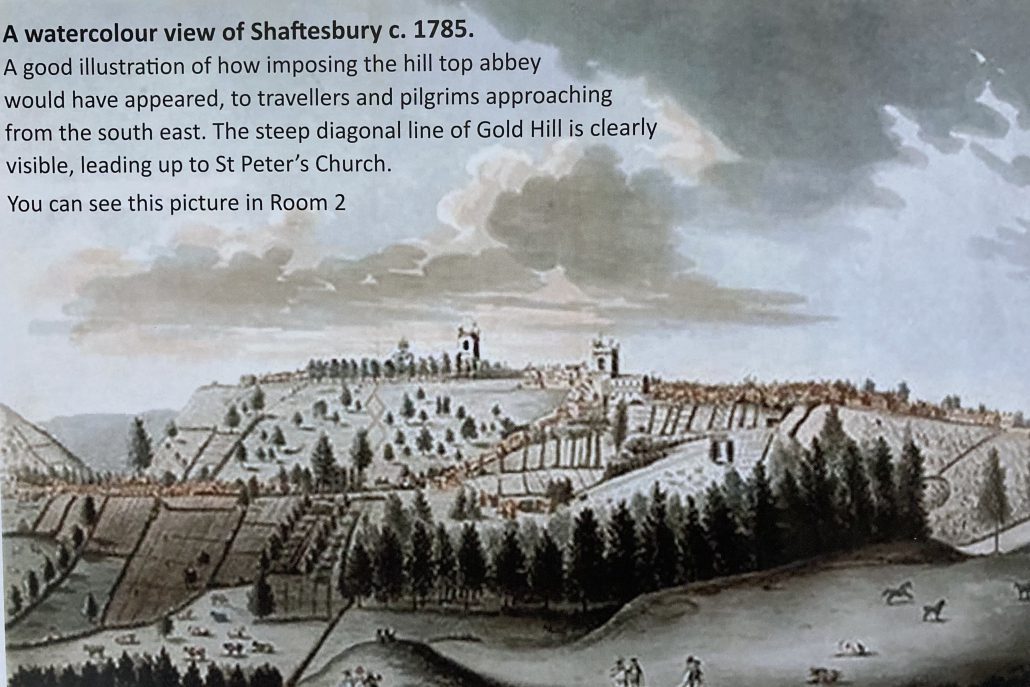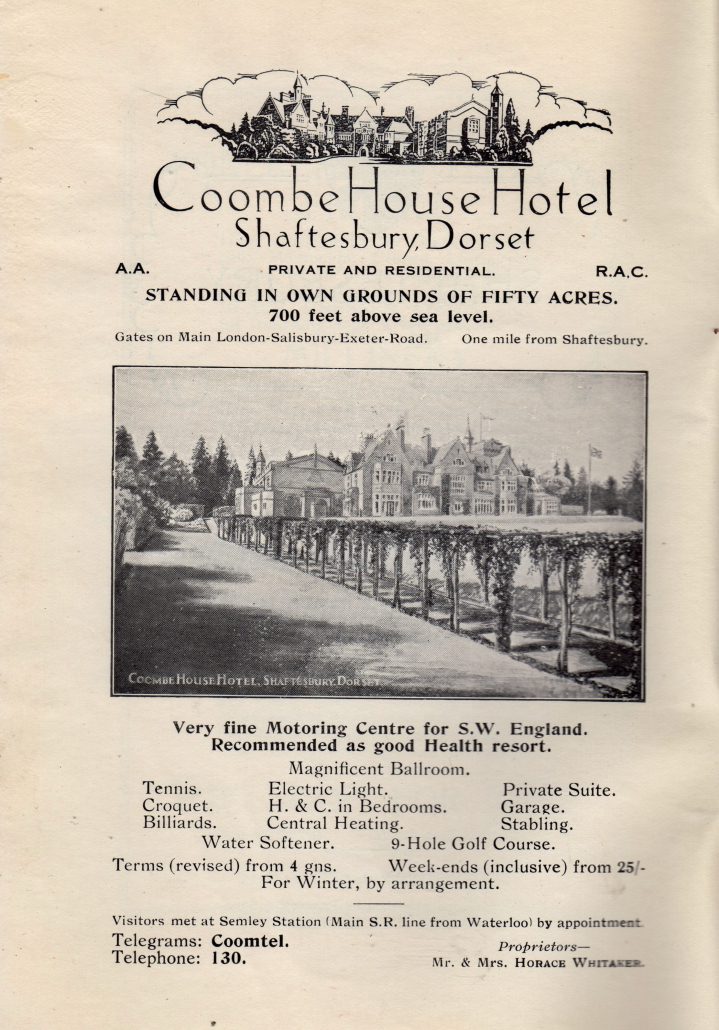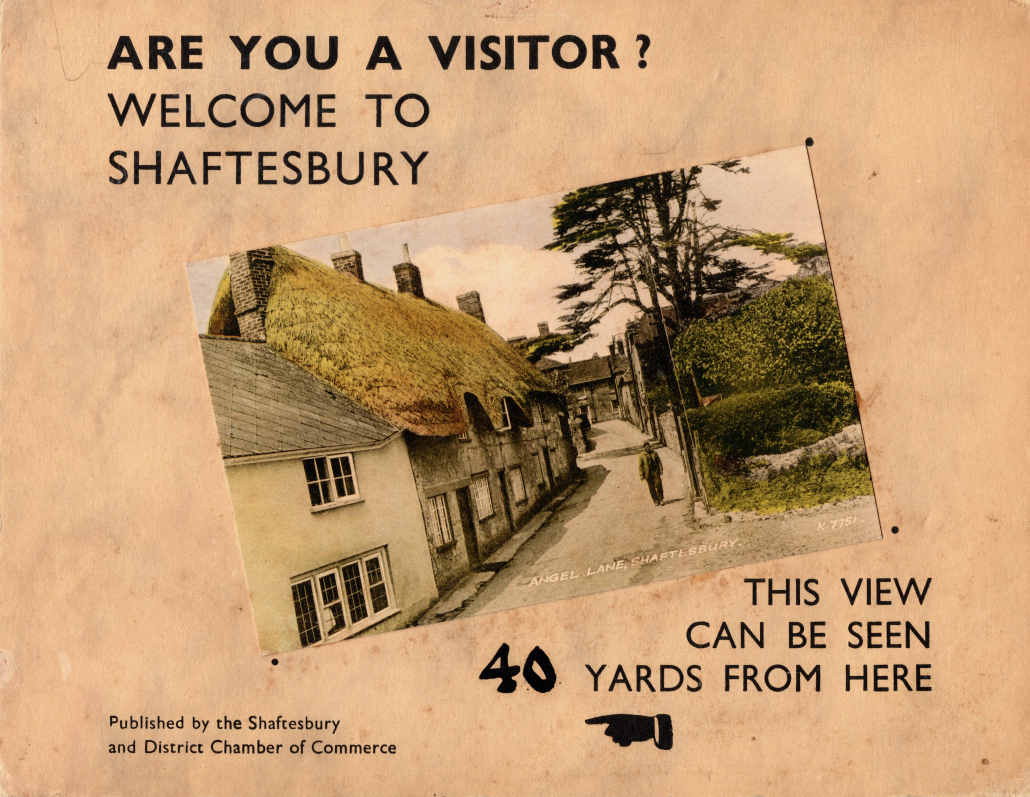“Commanding Scenery” and “Very Fine Air for the Restoration of Health”
“Welcome to Shaftesbury” is our final temporary exhibition of the season, showcasing a range of local printed tourist guides selected by our volunteer archives team and spanning nearly a century. Magnificent views to north, south, and west from Shaftesbury’s hilltop location are extolled by all the writers. (We are still doing it, with the benefit of drone photography, in the promotional video on our Home Page.) The earlier publicists tend to be equally interested in stressing the merits of Shaftesbury as a health resort, a kind of mini-Switzerland for the tubercular.

The earliest tourists would be medieval pilgrims, attracted to the shrine of St Edward the Martyr (d.978) at Shaftesbury Abbey. While many might have been motivated by the prospect of remission of sins and shortening of time spent in Purgatory, others would also have hoped for miraculous cures from the plethora of diseases rife at the time. Roger Mason, writer of the RH Guide above, states that The pilgrims visiting Edward’s shrine were so numerous … they caused hygiene problems, so they were housed in an area with a sloping floor, which could be easily sluiced out each morning.
One of the scourges of 19th century Britain was tuberculosis of the lungs. Records show that between 1851 and 1910 there were about 4 million deaths from TB in England and Wales. Robert Koch, the German scientist who demonstrated in 1882 that the disease was caused by infection from a bacterium, reckoned that TB was responsible for one-seventh of human mortality. Knowing the cause was not the same, however, as being able to prevent or cure the disease. Neither was feasible in Britain until widespread adoption of the BCG vaccination and availability of the antibiotic Streptomycin in the 1950s. Until then, TB was a commonplace and widely feared. Melvyn Bragg (b. 1939) recalls in his 2022 memoir Back in the Day that Wigton near Carlisle was swept by TB just after the war. My mother and I both caught it. Like many others, as a child I slept in the same bed as my mother. Diseases spread rapidly, especially in those cramped central streets … Ray Galton contracted TB aged 17 in 1947 and first met future comedy co-writer Alan Simpson as a fellow patient at Milford Sanatorium near Godalming. Later they achieved joint fame as creators of Hancock’s Half Hour and Steptoe and Son.
Victorian treatments varied from the optimistic: vinegar massages and inhaling turpentine fumes or hemlock; to the practical, but expensive: isolation in a plush Swiss sanatorium with plenty of bed-rest, good food, and fresh air. If altitude accompanied the fresh air, all the better, as the German physician Hermann Brehmer, returning from the Himalayas in 1854, claimed to be cured of TB. Brehmer initiated a trend by establishing a sanatorium 650 metres above sea level. Shaftesbury, at a more modest 215 metres, still warranted an entry in the the 1890s New Illustrated Guide to some of the Picturesque Health and Holiday Resorts on the Midland Railway System. (Change at Templecombe if travelling from the Midlands and the North.) South-Western Railways advised that Passengers taking tourist tickets to the West of England will be allowed to break the journey at Semley Station … in order to visit the town of Shaftesbury, two miles distant, situate about 780 feet above the level of the sea, recommended by medical men as a health resort for persons requiring bracing air, and commanding landscape views that for extent and grandeur are scarcely surpassed in the kingdom.

By the 1930s hoteliers advertising (above) in the Shaftesbury Tourist Guides had to be more cognisant of the expectations of travellers who might arrive by private motor car. The beneficial, health-giving climate was still a selling point. Coombe House’s “Magnificent Ballroom” was added c.1912 by the first owner, the vinegar tycoon, M.P., philanthropist, and all-round sportsman Mark Hanbury Beaufoy (1854-1922). His son sold off the estate in 1930. The 9-Hole Golf Course was probably carved out of acreage originally reserved for pheasant shooting. Subsequently Coombe House was occupied by USAAF bomber crews for R & R during World War Two, and after 1945 by the Sisters of The Institute of the Blessed Virgin Mary who operated an independent Girls’ School until its closure in 2020.

Welcome to Shaftesbury is on show in Exhibition Space ‘A’ outside the Museum Library until the end of the season in late October. Like all our displays, it is free to view every day between 10.30 and 4.30.



